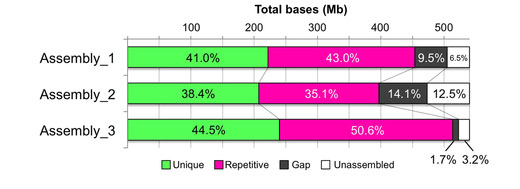Research Abstract
真核生物ゲノムのde novoアセンブリーで一分子リアルタイム配列解読法が発揮する威力
The power of single molecule real-time sequencing technology in the de novo assembly of a eukaryotic genome
2015年11月30日 Scientific Reports 5 : 16780 doi: 10.1038/srep16780

第二世代シーケンサー(SGS)は画期的なものであり、低コストで多くの非モデル生物のゲノム解読を実現した。しかし、SGSによるゲノム解読では、ゲノムの少なくない部分が未解読のまま放置されてしまう。そこで我々は、一分子リアルタイム(SMRT)シーケンス法を利用してアズキ(Vigna angularis)のゲノムを再構築し、現在解読されているマメ科作物のなかで最も優れた連続性およびカバー率を達成した。SMRTシーケンス法によるアセンブルは、SGSによるアセンブルと比較して、コンティグ長は100倍となり、ギャップも100分の1に減少した。また、SMRTシーケンスによるアセンブルではほぼ全ての遺伝子を網羅していたのに対して、SGSによるアセンブルでは数千個の遺伝子が消失または断片化していることが明らかとなった。さらに、高密度の連鎖地図に基づいて染色体を再構築し、アズキゲノムの86%までを復元することに成功した。SMRTシーケンス法は、なおSGSデータによる補正がある程度必要ではあるが、真核生物ゲノムのほぼ完全な解読を実現することが実証された。
Hiroaki Sakai, Ken Naito, Eri Ogiso-Tanaka, Yu Takahashi, Kohtaro Iseki, Chiaki Muto, Kazuhito Satou, Kuniko Teruya, Akino Shiroma, Makiko Shimoji, Takashi Hirano, Takeshi Itoh, Akito Kaga & Norihiko Tomooka
Corresponding Author
Second-generation sequencers (SGS) have been game-changing, achieving cost-effective whole genome sequencing in many non-model organisms. However, a large portion of the genomes still remains unassembled. We reconstructed azuki bean (Vigna angularis) genome using single molecule real-time (SMRT) sequencing technology and achieved the best contiguity and coverage among currently assembled legume crops. The SMRT-based assembly produced 100 times longer contigs with 100 times smaller amount of gaps compared to the SGS-based assemblies. A detailed comparison between the assemblies revealed that the SMRT-based assembly enabled a more comprehensive gene annotation than the SGS-based assemblies where thousands of genes were missing or fragmented. A chromosome-scale assembly was generated based on the high-density genetic map, covering 86% of the azuki bean genome. We demonstrated that SMRT technology, though still needed support of SGS data, achieved a near-complete assembly of a eukaryotic genome.

